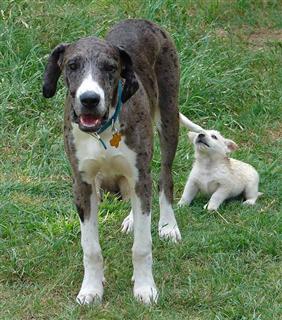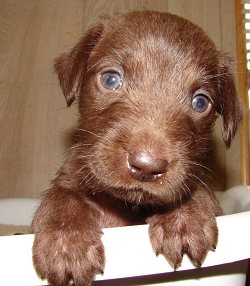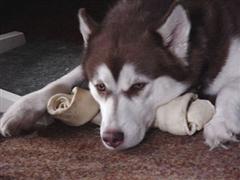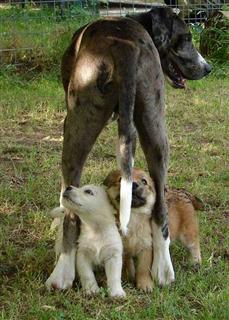|
1. The people in the family the dog growls at must be the only ones to feed the dog. Give the dog a command before giving them their food. If a dog does not follow the command (i.e. to sit), he does not eat. Try again in about 20 minutes or longer. Repeat this until the dog listens to the command.
2. All humans must eat Before the dogs, as the leader always eats first. When you give your dog its food eat a small snack first while he is watching, lay the snack near the dogs food so that he thinks you are eating out of his bowl (the leader always eats first)
3. No table scraps should be fed to the dogs during a meal.
4. Feedings must be at a scheduled time. (no self feeding dog food dispensers should be used, as this allows The Dog to Choose when he eats.)
5. Humans must not let the dog go through any doorways first. Dogs must always go through the doorways After the humans, as the leader of the pack always goes first. The dog must be told to "stay" and given the command to "come" after all humans have passed through. (Read Training to find out the necessary basic commands all dogs should know)
6. When you have left the house or the room, even for a minute and come back in the room, ignore the dog for a few minutes.
7. A simple obedience command such as “Sit” should be given before any pleasurable interaction with the dog. (i.e. play session, petting, feeding or a walk etc…) The children should give the dogs commands at least once a day and reward with a treat when the command is followed. A simple “Sit” will do. No treat should be awarded if the dog does not follow the command.
8. You should not lay on the floor to watch TV when the dog is around and no one should roll around the floor playing with the dogs, as a human should never put himself in an equal or lesser height position than the dog.
9. You are the one who greets newcomers first, the dog is the last who gets attention (the pack leader is the one who greets newcomers and lets the rest know when it is safe to greet the newcomer)
10. If a dog is laying in your path, the dog Must get up and move out of your way. Do not step over the dog even if you can. In the wild, the pack leader always makes the lower dogs in the pack move.
11. During the time you are establishing your higher pack position, no hugs should be given to the dog by you, as a dominant dog may consider this a challenge of power. |
 |
12. If you establish eye contact with the dog, the dog must avert his gaze first. If the human averts first this reinforces the dogs higher power position. Tell the children Not to have staring contest with the dog, as if they avert or blink first, it will only reinforce, in the dogs mind, that He is Top Dog.
13. Dogs must not sleep in your bed. The comfortable bed is reserved for the higher humans.
14. Dogs must never be allowed to mouth or bite anyone at any time, including in play.
15. Any attention given to the dog, including petting should be given when the Human decides attention is to be given (absolutely No Petting when the dog nudges or paws you or your hand. This would be letting the dog decide and reinforcing, in his mind, that he is higher on the scale than the human.)
16. Games of fetch or play with toys must be Started and Ended by the Human.
17. Dogs should not be allowed to lie on your furniture, as the leader of the pack always gets the most comfortable spot. Dogs belong on the floor.
18. No tug-of-war, as this is a game of power and you may lose the game giving the dog a reinforcement (in the dog's mind) of top dog.
19. Dogs need to be taught a “Drop it” or release command. Any objects the dog has in his possession should be able to be taken away by all humans.
20. Dogs own no possessions, everything belongs to the humans. They are all on "loan" from the human family. You should be able to handle or remove any item at all times from the dog with no problems from the dog. Even if you are taking a chicken bone out of the dog's mouth.
21. Dogs should not be allowed to pull on the leash. When they do this they are leading the way and it is the humans that need to lead the way and show they're higher up in the pack order. (In the wild, the leader of the pack always leads the way; the leader leads the hunt.)
22. When on a walk, a dog must not be allowed to sniff or eliminate anywhere he wishes. One marking against a tree is enough for male dogs.
23. Small dogs or puppies who demand to be picked up or put down should Not get what they want until they sit or do another acceptable quiet behavior. They should not be put down unless they are settled quietly in your arms.
24. Dogs should Never be left unsupervised with children or Anyone who cannot maintain leadership over the dog.
The Energy Connection
Bringing Out the Dog's State of Mind
Knowing how to fulfill a dog will allow her to live in a balanced way.
A lot of my clients call their dogs their soul mate or their son. But the dog tears up the furniture or drags the client all over the neighborhood on a walk. The client pleads with the dog to behave, cajoles the dog, and offers her treats with no change in the dog’s behavior.
Why? Dogs are animals, and they respond to calm-assertive leadership not emotional arguments or negotiations.
Fulfillment Formula
Even if you don’t know anything about dogs or dog psychology, knowing how to fulfill a dog will allow him to live in a balanced way and achieve a healthy state of mind.
Dogs don’t need humans to achieve balance; we need to help them achieve balance when they live in our world. It’s our responsibility to fulfill their needs as nature intended them to be fulfilled within the pack.
How does this work? Through my fulfillment formula: exercise, then discipline and, finally, affection. As the human pack leader you must set boundaries, rules and limitations and always project a calm, assertive energy.
Getting Off Track
The way people like to fulfill their dogs is love first, then affection and no leadership.
The term fulfillment means fulfilling your life in the way nature intended it, whether you are a dog or a zebra or a human.
Affection and love fulfill humans, not dogs. Dogs don’t need affection from us to feel balanced or aligned. These are human needs.
We must remember this in our relationships with our dogs. For fulfillment, you as pack leader and the dog as follower must happen every day.
We will achieve that “in love” feeling that every dog owner wants when we take responsibility for our dogs’ state of mind before our own.
Finally, remember that “in love” doesn’t mean connection. You will only connect with your dog and feel in tune with her when you fulfill her on a primal level as nature intended it.
Dogs don’t know each other by name; they know each other by the energy they project and the activities they share.
The first energy that a puppy experiences after birth is his mom’s calm-assertive energy. Later, the puppy will follow a pack leader who projects the same calm-assertive energy out of association.
Make Like a Leader
Dogs use constant energy to communicate. (Energy is what I call beingness: who and what you are at every moment.)
Dogs don’t know each other by name; they know each other by the energy they project and the activities they share. They also know humans in the same way.
The pack leader always projects a calm-assertive energy. (If you don’t know what I mean by calm-assertive energy, think about Oprah Winfrey. She is calm and assertive in the human world.)
The key to earning your dog’s respect as the pack leader is to understand the nature of the pack and to duplicate the action and attitude of the pack leader. The pack leader controls everything: when the pack eats, when they play, and how far they can walk.
Calm-Submissive Energy
The pack followers return a calm-submissive energy that completes the pack balance. Most dogs are born submissive, because there can only be so many pack leaders.
Some submissive dogs who live with humans that do not lead will attempt to right the pack balance by filling what they see as a vacant pack leader role out of necessity.
This is very unhealthy, because it creates an unstable state. Remember, these dogs were born to follow calm-submissive energy. This is often at the root of problem behaviors, because you have a submissive dog trying to lead in the only way it knows how. These dogs are often identified by nervous, fearful, or other unwanted behaviors.
Your goal is to provide calm-assertive leadership to your dog one hundred percent of the time (just like he would experience in the pack). This natural balance (calm-assertive leadership with calm-submissive behavior) nurtures stability and creates a balanced, centered and happy dog.
The Best Gift
The most loving gift you can give your dog is to become her calm-assertive pack leader. It’s a gift that both you and your dog will enjoy.
To refocus your dog’s behavior, you must challenge him physically and psychologically.
One of the most important things I want to get across is that dogs are animals, not humans.
Many times the solutions we use for humans are totally wrong for solving a dog’s issues. For example, when a human sees a scared or nervous dog, s/he will first offer comfort and consolation. In the animal world, this would never happen, because it enforces unstable behavior. Ironically, a human in this situation can make the problem worse instead of better.
To refocus your dog’s behavior, you must challenge him physically and psychologically.
Challenge Your Dog Physically
All dogs require exercise to lead balanced, healthy lives. Just because a dog is small doesn’t mean she needs less exercise. The breed type can give an indication of the dog’s energy level, but the final judgment must be made on the individual dog’s needs.
As your dog’s pack leader, you must help her to expend her energy in a productive way. For most dogs, this means a daily walk.
Master the walk and your dog will relate to you on a primal level. Remember that dogs are animals, and animals love to travel and discover the world. Just like Columbus or Magellan, dogs possess an innate need to cover new ground. A big back yard is no substitute for a good walk.
Challenge Your Dog Psychologically
The canine pack leader requires his followers to work for food and water. This work is mostly psychological and comes in the form of waiting, for example, waiting to eat or waiting to travel.
A good way to refocus your dog’s behavior is to ask him to wait a moment before he eats. Only when he achieves a calm-submissive state, do you put down the bowl of food.
The same is true for daily walks. Put the leash on your dog and have him sit and wait a moment. Only when you say OK is it time to begin your journey out into the world.
These simple exercises provide excellent mental stimulation and help your dog ease into a calm-submissive state of being.
References:
Dogbreedinfo.com
Cesar Millan Inc
|



